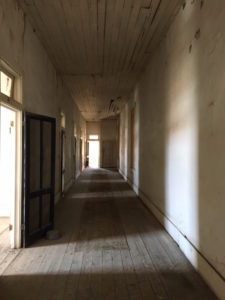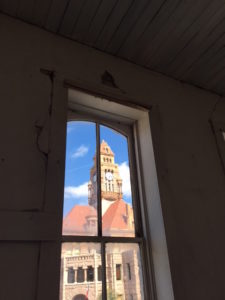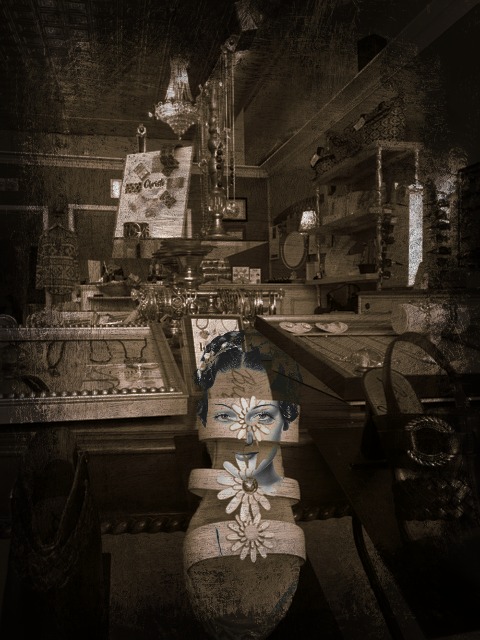Gose Trees Planted in 1861
402 W Walnut St, Decatur, TX
Remnant of bois d’arc hedge which encircled the log cabin of Stephen M. Gose (1824-77), early justice of the peace, blacksmith, and leader of Methodist church, who came to Texas from Missouri in 1859. The spiny trees, planted 1861, served as a barrier against prowling Indians.
The tree was used in the hedge rows of cattle farmers prior to the advent of steel, barbed wire fencing. They would have been planted them a few feet apart, in straight rows and the limbs would have entangled themselves together making an impenetrable hedgerow, by cattle or man.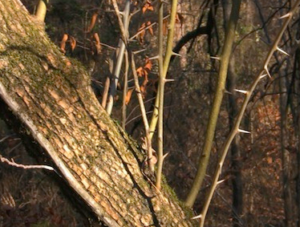
This usage of the tree led to one of its names; Hedge Apple. It primarily grows in the South Central States of the US. However, the Hedge Apple can still be found throughout the Farm lands all over, especially in old fence-rows where the seeds have resisted modern farming and planting and all efforts to eradicate the nasty tree.
The word “apple” is quite misleading. The tree yields a fruit unlike many; a bumpy, green, 4-5 inch ball that resembles a green brain. In Louisiana, the kids referred to the fruit as “monkey brains”. A very fitting description, actually; I am told they throw them at one another. This fruit is completely inedible, as it has, inside of it, a liquid that has the texture of latex paint, a rather unpleasant odor, that will irritate your skin if it gets on you.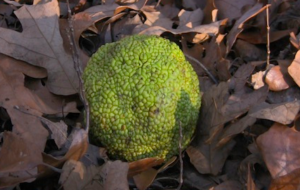
The older generation would use the fruit, cut in half, laid around the foundation of their homes, to repel insects naturally. These would eventually break down into a soft, slimy mess and rot. Simply repulsive is the only description I can come up with for the entire affair.
By all standards of the outside world, the tree is useless. Repulsive. Completely un-inviting. With the advent of barbed wire and fence posts, modern day insecticide, the tree was rendered useless. The thorns are even laced with a sap that will leave a terribly painful sore if one is pricked by their needle sharp tip and the wood is so hard and dense and resistant to rot, the best use for it was to cut it down and saw it into fence posts, which was the end result for thousands of the trees around the end of the 1800’s. Some of those fence posts are still found and used today, as they have weathered the harsh conditions for more than a century.
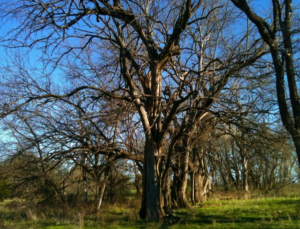 The modern day arborist would advise you to stay away from the very idea of this tree when considering what you might plant on your property as its reputation is horrible. It drops its seedlings everywhere, which thrive in almost any condition, and are virtually impossible to kill out. It is the epitome of the nightmare tree.
The modern day arborist would advise you to stay away from the very idea of this tree when considering what you might plant on your property as its reputation is horrible. It drops its seedlings everywhere, which thrive in almost any condition, and are virtually impossible to kill out. It is the epitome of the nightmare tree.
The name Bois d’arc came from the French settlers when they realized the Osage and Comanche Indians used this tree, almost exclusively, for making their bows. The grains run very straight on short sections, and the wood is flexible and very hard and resistant to cracking. It is extremely strong and will last for years under the pressures of bending as a bow. In fact, the popularity of the wood for bows was so great that many Native American tribes would travel hundreds of miles to acquire the wood to make their bows. “Bois d’arc” means “bow wood” in French.
So, on the inside, behind all of that bad, nasty tree, there is a particular strength and heartiness to the wood that cannot be found in any other wood on this continent.

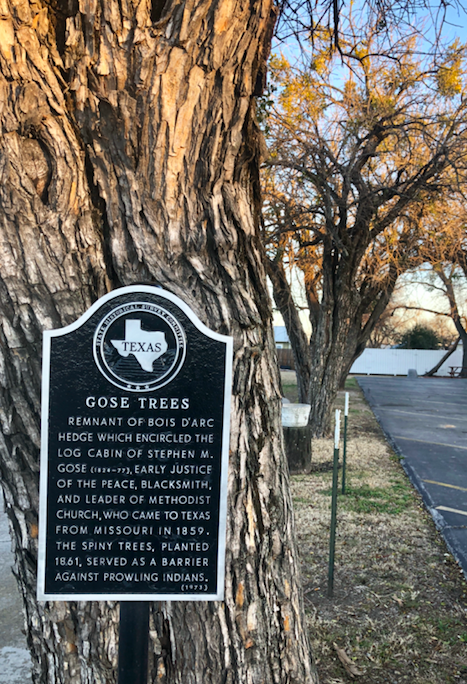

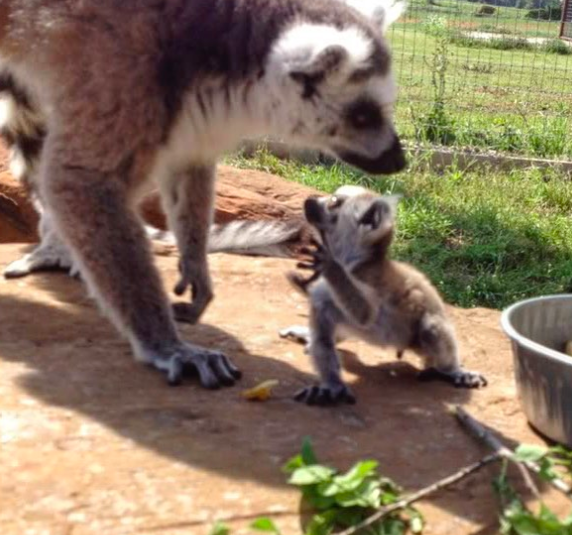
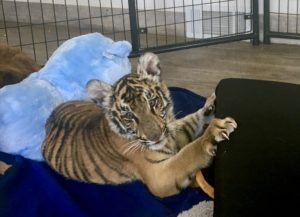 Baby Zara has recently found a forever home at C.A.R.E. Weighing only twenty-seven pounds, far smaller than typical for her age; this little one is fascinating to watch. Her big paws indicate how large she will one day be as she happily splashes water out of her pail. A nearby Clorox bottle with many small indentions proves how sharp her teeth are. She is spending time indoors while a green-stick fracture to her leg heals and what a set-up she has! At the time of our visit, she was watching Finding Nemo on her big screen TV. Finding a type of bedding she cannot destroy is quite the feat. She was already on her third bed of the day, but that one was holding up pretty well so far. She has completely destroyed others in a matter of seconds! Interestingly her enclosure is filled with stuffed animals that she loves on without ruining. She is genetically quite hyper and finds it hard to settle down. Zara has been raised alone, but Heidi Krahn, director of the facility, thinks she might benefit from a friend and is actively looking for another tiger to fit the bill. This baby is lovingly watched over by caretakers that willingly stay all night with her. During our visit Bagheera the house cat came strolling through with no fear whatsoever only to show her great displeasure of the new resident. We also witnessed contented purrs during a bonding moment with Heidi’s son. She is not a pet, however. As soon as her injury heals, she will be outdoors in an enclosure.
Baby Zara has recently found a forever home at C.A.R.E. Weighing only twenty-seven pounds, far smaller than typical for her age; this little one is fascinating to watch. Her big paws indicate how large she will one day be as she happily splashes water out of her pail. A nearby Clorox bottle with many small indentions proves how sharp her teeth are. She is spending time indoors while a green-stick fracture to her leg heals and what a set-up she has! At the time of our visit, she was watching Finding Nemo on her big screen TV. Finding a type of bedding she cannot destroy is quite the feat. She was already on her third bed of the day, but that one was holding up pretty well so far. She has completely destroyed others in a matter of seconds! Interestingly her enclosure is filled with stuffed animals that she loves on without ruining. She is genetically quite hyper and finds it hard to settle down. Zara has been raised alone, but Heidi Krahn, director of the facility, thinks she might benefit from a friend and is actively looking for another tiger to fit the bill. This baby is lovingly watched over by caretakers that willingly stay all night with her. During our visit Bagheera the house cat came strolling through with no fear whatsoever only to show her great displeasure of the new resident. We also witnessed contented purrs during a bonding moment with Heidi’s son. She is not a pet, however. As soon as her injury heals, she will be outdoors in an enclosure.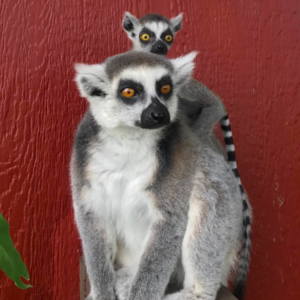 Knowing the little one would either die from malnutrition or be unaccepted and killed by the troop, she set about to save her. Little Momo was fed two drops of soy formula every thirty minutes around the clock eventually moving to a blended mixture of milk, cheerios, Activia yogurt, banana and aloe vera juice. She began to thrive, and slowly, slowly Heidi commenced to introduce the baby to the troop consisting of Rita, the alpha female, Mrs. Stewart, and Mort. The moment of truth was the scariest day Heidi had experienced. She knew the troop could very well kill little Momo, but luckily Rita’s motherly instincts were deep-seated. Momo jumped on Rita’s back, and she has been a part of the family ever since. As we rounded the corner to the lemur house, Heidi called out, “Rita show us your baby.” What happened next was nothing short of magical! Out dashed a lemur with an impossibly small baby clinging to her back. Momo now weighs 420 grams, but she is still so tiny. We watched in awe at the interaction and tricks of this baby, her lack of fear often leaving us nervous and even gasping! She has gone from near death to acrobat extraordinaire. There are still hurdles to face. When she turns a year and a half to two years old, there could be problems, but for now, it is an unheard of happy ending. While an alpha female has been known to take a baby from within a troop, there has never been an instance of one accepting an unrelated baby from outside the troop as her own. The lemurs at C.A.R.E. are unusual to begin with because they love people and they love each other. Such happy news for some of the earth’s most endangered species.
Knowing the little one would either die from malnutrition or be unaccepted and killed by the troop, she set about to save her. Little Momo was fed two drops of soy formula every thirty minutes around the clock eventually moving to a blended mixture of milk, cheerios, Activia yogurt, banana and aloe vera juice. She began to thrive, and slowly, slowly Heidi commenced to introduce the baby to the troop consisting of Rita, the alpha female, Mrs. Stewart, and Mort. The moment of truth was the scariest day Heidi had experienced. She knew the troop could very well kill little Momo, but luckily Rita’s motherly instincts were deep-seated. Momo jumped on Rita’s back, and she has been a part of the family ever since. As we rounded the corner to the lemur house, Heidi called out, “Rita show us your baby.” What happened next was nothing short of magical! Out dashed a lemur with an impossibly small baby clinging to her back. Momo now weighs 420 grams, but she is still so tiny. We watched in awe at the interaction and tricks of this baby, her lack of fear often leaving us nervous and even gasping! She has gone from near death to acrobat extraordinaire. There are still hurdles to face. When she turns a year and a half to two years old, there could be problems, but for now, it is an unheard of happy ending. While an alpha female has been known to take a baby from within a troop, there has never been an instance of one accepting an unrelated baby from outside the troop as her own. The lemurs at C.A.R.E. are unusual to begin with because they love people and they love each other. Such happy news for some of the earth’s most endangered species.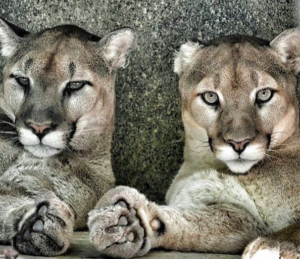 Making our way down the hill, we come upon a staked section in a serene, secluded area with incredible views. This will be the home for two mountain lions coming from the Dallas Zoo. A campaign has already begun to raise the money for what will be the most costly venture that C.A.R.E. has undertaken to date. The beautiful enclosure will feature a glass room for visitors to observe and eat as well as suites to spend the night while offering these two lucky mountain lions a fantastic habitat to call home.
Making our way down the hill, we come upon a staked section in a serene, secluded area with incredible views. This will be the home for two mountain lions coming from the Dallas Zoo. A campaign has already begun to raise the money for what will be the most costly venture that C.A.R.E. has undertaken to date. The beautiful enclosure will feature a glass room for visitors to observe and eat as well as suites to spend the night while offering these two lucky mountain lions a fantastic habitat to call home.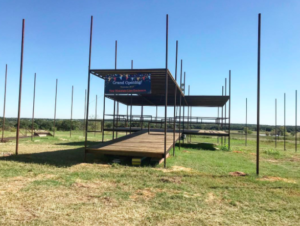 As Heidi ignores all road blocks and continues to work tirelessly to provide a meticulously maintained and loving environment for the beloved animals entrusted to her, we celebrate this new season with her and all those involved in making C.A.R.E. the remarkable facility that it is.
As Heidi ignores all road blocks and continues to work tirelessly to provide a meticulously maintained and loving environment for the beloved animals entrusted to her, we celebrate this new season with her and all those involved in making C.A.R.E. the remarkable facility that it is.

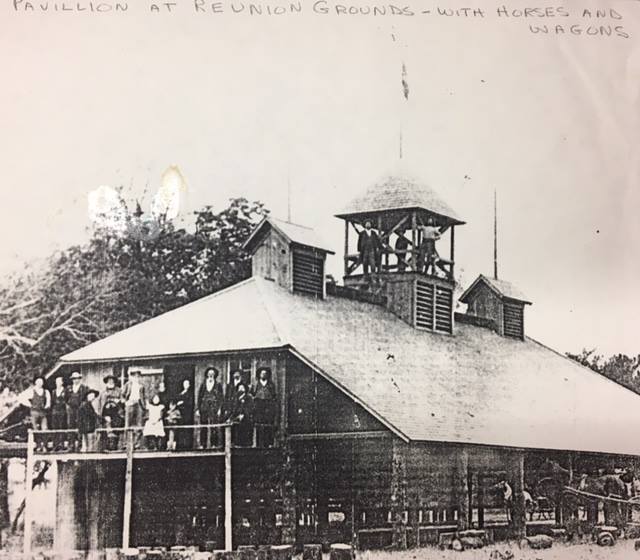
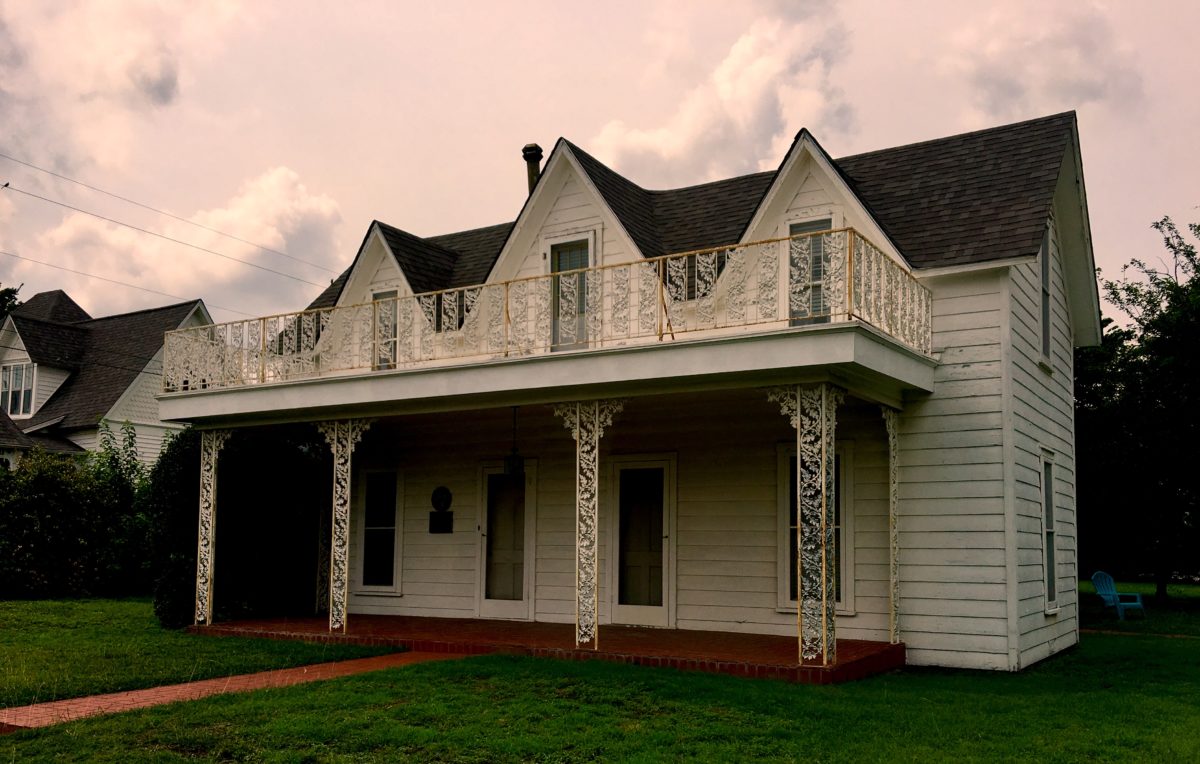
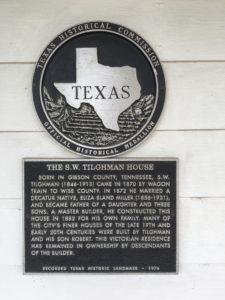 As Pioneers moved west, they made do with tools and materials indigenous to the area when building their homes. Log cabins and sod houses were the norms. By 1900 the typical American home was less than 1,000 square feet. While indoor plumbing and electricity were available, they were not common. Porches were a must for the hot Texas summers. Dog-trot houses were prevalent for their large breezeways in the center of the home. Americans, while borrowing from historical styles such as Greek and Roman, were at the same time fashioning a style that would become uniquely American with an emphasis on comfort. Most towns now had sawmills making gingerbread trim, columns and cornices available. Even simple frame houses made use of architectural elements. Neat and orderly homes portrayed a sign of progress and new wealth attracting newcomers to the community. Rapid expansion was creating the need for housing in Decatur!
As Pioneers moved west, they made do with tools and materials indigenous to the area when building their homes. Log cabins and sod houses were the norms. By 1900 the typical American home was less than 1,000 square feet. While indoor plumbing and electricity were available, they were not common. Porches were a must for the hot Texas summers. Dog-trot houses were prevalent for their large breezeways in the center of the home. Americans, while borrowing from historical styles such as Greek and Roman, were at the same time fashioning a style that would become uniquely American with an emphasis on comfort. Most towns now had sawmills making gingerbread trim, columns and cornices available. Even simple frame houses made use of architectural elements. Neat and orderly homes portrayed a sign of progress and new wealth attracting newcomers to the community. Rapid expansion was creating the need for housing in Decatur!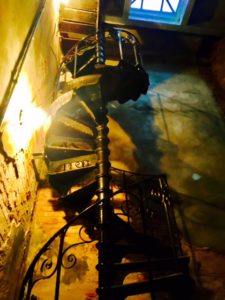
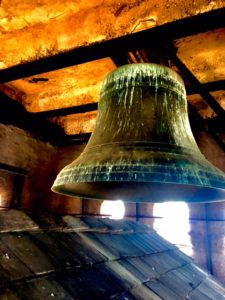

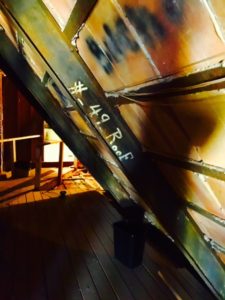
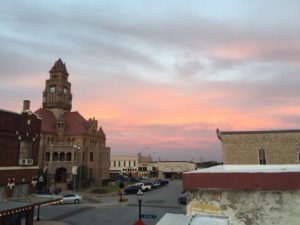
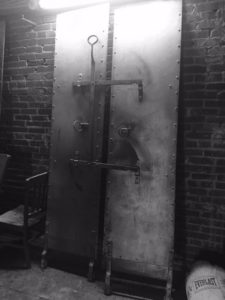
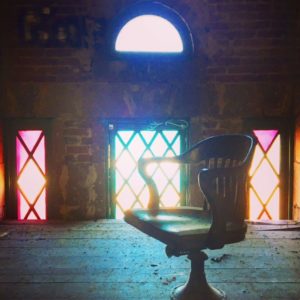
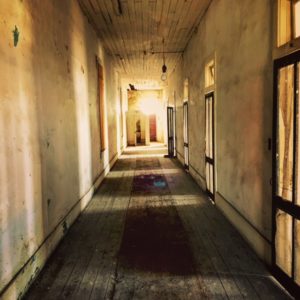
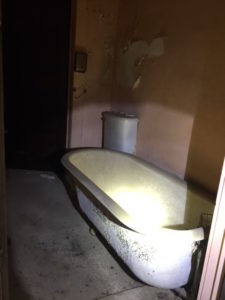
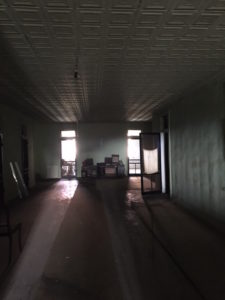 With a turn to the left a separate, smaller section of the hotel comes into view. Who stayed here? Cattle-ranching was big business, and the cowboy was integral to the operation. The trail ride was long and hard with constant threat from weather and Indians. The end of the ride was the time the cowboy got paid and could let down and be rowdy. Such activity mostly entailed drinking and practical jokes. As a result, they were considered the “lower class” citizens of the hotel and housed in a discrete area…hence the “Cowboy Hotel”. If you squint down the impossibly long hallway with light streaming in from floor to ceiling windows you can see shadows of cowboys collapsing from a night of hard drinking. There is not much of a bathroom, because they really did not deserve it. They were dirty and gamey. Was it noisy in this section of the hotel or just the rumbling snores of those sleeping off a hard ride? If only these walls could talk. Single, naked light bulbs hang from original knob and tube wiring. A few scuff marks from spurs are still visible.
With a turn to the left a separate, smaller section of the hotel comes into view. Who stayed here? Cattle-ranching was big business, and the cowboy was integral to the operation. The trail ride was long and hard with constant threat from weather and Indians. The end of the ride was the time the cowboy got paid and could let down and be rowdy. Such activity mostly entailed drinking and practical jokes. As a result, they were considered the “lower class” citizens of the hotel and housed in a discrete area…hence the “Cowboy Hotel”. If you squint down the impossibly long hallway with light streaming in from floor to ceiling windows you can see shadows of cowboys collapsing from a night of hard drinking. There is not much of a bathroom, because they really did not deserve it. They were dirty and gamey. Was it noisy in this section of the hotel or just the rumbling snores of those sleeping off a hard ride? If only these walls could talk. Single, naked light bulbs hang from original knob and tube wiring. A few scuff marks from spurs are still visible. Time has passed the beautiful hotel by. It has been decades since its most famous visitor, Amelia Earhart stayed. It is hard to believe the hotel operated past 1940. However, the doors stayed open until 1974. The building is still owned by the third generation of a family that purchased it in the 1930’s.
Time has passed the beautiful hotel by. It has been decades since its most famous visitor, Amelia Earhart stayed. It is hard to believe the hotel operated past 1940. However, the doors stayed open until 1974. The building is still owned by the third generation of a family that purchased it in the 1930’s.
